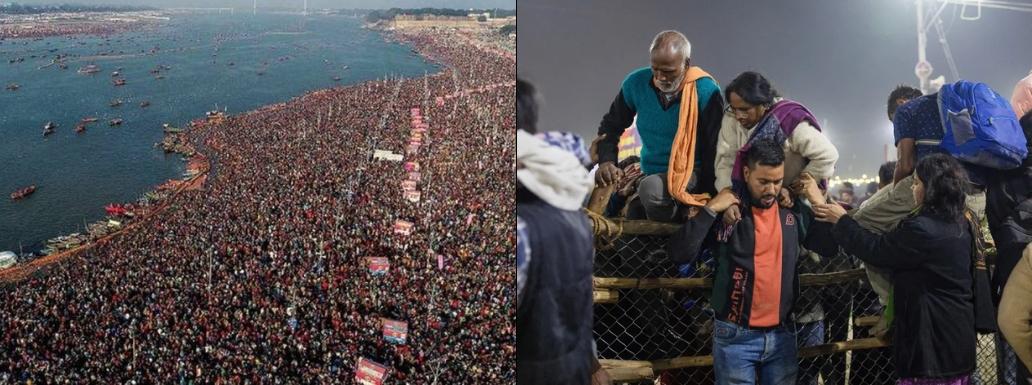Monday 17 November 2025
Digital Kumbh: A Technological Promise That Failed to Prevent Tragedy
Share

The 2025 Kumbh Mela in Prayagraj, hailed as the‘Digital Kumbh’due to its incorporation of artificial intelligence (AI) and cutting-edge surveillance technology, was marred by a tragic stampede that claimed the lives of around 30 pilgrims. Despite the extensive use of AI-powered crowd monitoring, drone surveillance, and RFID wristbands, the disaster could not be averted, raising serious questions about the effectiveness of these technological advancements.
On Wednesday, amid a surge of millions of pilgrims gathering for the sacred Mauni Amavasya bath, chaos erupted when a barrier collapsed, leading to a stampede that resulted in fatalities and injuries. The accident was exacerbated by the continuousmovement of VIPsand the closure of key bridges for three days due to the Amrit Snan. The resulting crush left many trapped and trampled, highlighting a critical failure in crowd management.
The Kumbh Mela, one of the largest religious gatherings in the world, is expected to attract up to 400 million visitors over six weeks, making crowd control an immense challenge. The promise of AI-powered technology was to mitigate such risks, ensuring safety and efficiency in managing the surging crowds. However, the reality proved starkly different.
Authorities had touted AI-based crowd monitoring as a breakthrough in pilgrimage management. The control system relied on 300 high-resolution cameras mounted across the festival site and an army of drones monitoring crowd movements. The data was fed into an AI algorithm designed to estimate crowd density in real-time. Additionally, AI-enabled wristbands and mobile tracking apps were introduced to streamline pilgrim movement.
However, one of the most significant failures of this system was its gross underestimation of attendance. On the very first day, AI-powered cameras reportedly recorded amere 40,000 attendeeswhen the actual footfall was estimated at around 30 million. This astronomical discrepancy rendered the entire system ineffective from the outset, leaving authorities blind to potential crowd surges and choke points.
Beyond faulty AI estimates, the failure to integrate real-time corrective measures exacerbated the situation. Despite having a command center equipped with live data from drones and CCTV feeds, authorities could not prevent bottlenecks from forming. The rigidity of the AI models, which failed to adapt to real-world complexities such as sudden surges due to VIP movements or religious timings, further weakened the systems ability to respond effectively.
Experts have pointed out that Indias high population density and cultural norms of personal space require differentcrowd control thresholdsthan Western models. While the international standard for raising an alarm is three to four people per square foot, Indian events often see significantly higher densities before intervention is deemed necessary. This may have led to a dangerous delay in addressing warning signs before the situation spiraled out of control.
Despite prior knowledge that the Kumbh Mela would see over 400 million attendees, predictive models failed to provide accurate insights. Authorities claimed that AI-powered forecasting tools would help allocate resources and plan for peak days, but the tragic events suggest otherwise. The reliance on technology without complementary human intervention and real-time adaptability led to a critical oversight in managing the crowd effectively.
The movement of VIPs added another layer of complexity, as road closures and restricted zones forced ordinary pilgrims into tighter, uncontrolled spaces. This mismanagement, combined with technologys failure to provide actionable intelligence, directly contributed to the stampede.
To regulate crowd movement, the entire fairground was designated as a no-vehicle zone. Barricades were placed along the riverbanks to manage the flow of people, and special arrangements were implemented across all sectors to streamline movement. Over 2,000 new signboards were installed to assist devotees and ensure smooth navigation.
All parking areas were operational and equipped with essential amenities, with vehicles being directed to the nearest available zones and then to alternative locations based on a structured traffic plan. Despite these efforts to control traffic and crowd density, the stampede highlights the need to reevaluate congestion management strategies in high-density areas.
The Maha Kumbh Mela is one of the largest religious gatherings in the world, held every 12 years at Prayagraj (Allahabad), Haridwar, Nashik, and Ujjain in India. It is a deeply sacred event for Hindus, where millions of devotees gather to take a holy dip in the river, believing it will cleanse them of sins and help attain salvation (moksha). Considering the crowds that gather, stampedes at Kumbh Mela are not new. Historical precedents include:
1954: A deadly stampede in Allahabad (now Prayagraj) claimed nearly 800 lives due to overcrowding on a Mauni Amavasya bathing day.
1986: Haridwars Kumbh Mela witnessed 200 deaths as security restrictions for VIPs triggered panic among devotees.
2003: A stampede in Nashik resulted in 39 fatalities during the holy dip at the Godavari River.
2013: A railway station stampede in Prayagraj killed 42 pilgrims when a footbridge collapsed due to overcrowding.
Newsletter
Stay up to date with all the latest News that affects you in politics, finance and more.